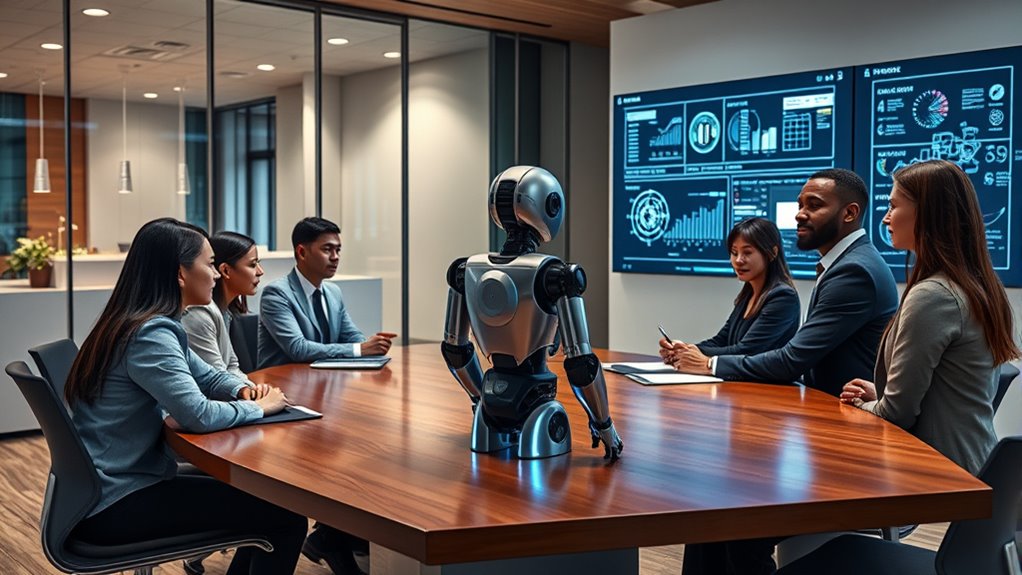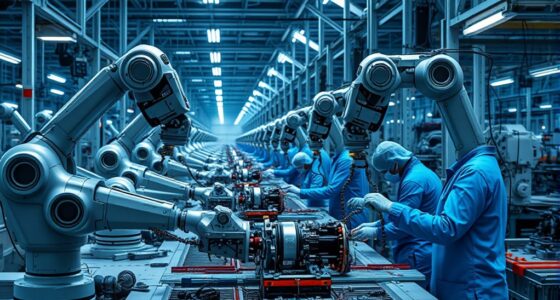As ChatGPT joins your team, you’ll notice it transforming daily workflows by automating routine tasks, boosting productivity, and sparking creativity. More companies are using AI like ChatGPT to improve decision-making and enhance collaboration, leading to faster, more accurate results. While adopting AI brings challenges like resistance and skill gaps, strategic integration can help you and your team grow. Keep exploring how AI coworkers are shaping the future of work and what’s next for your workplace.
Key Takeaways
- AI coworkers like ChatGPT enhance productivity by automating routine tasks and supporting creative processes within teams.
- Successful integration requires clear workflows, staff training, and transparent communication to address resistance and build trust.
- Human-AI collaboration is projected to generate trillions in value, boosting efficiency, innovation, and decision-making.
- AI tools assist in content creation, data analysis, and strategic insights, making teams more agile and data-driven.
- Preparing teams involves developing AI literacy, involving employees in AI adoption, and establishing ethical and regulatory frameworks.
The Growing Presence of AI in Workplaces

The presence of AI in workplaces is rapidly expanding as more companies recognize its potential to boost efficiency and reduce costs. The AI market is growing at a remarkable 35.9% CAGR, and by 2025, up to 97 million people will work in AI-related roles. Around 78% of global companies already use AI, with larger firms twice as likely to adopt it than smaller ones. Industry projections forecast the AI market reaching $1.85 trillion by 2030. AI is transforming how work gets done, saving employees an average of 2.5 hours daily and helping businesses cut costs—28% of leaders report savings. As AI becomes more integrated, it’s clear that its influence on workplaces will only intensify, shaping future business strategies and workforce dynamics. Additionally, the integration of AI tools like ChatGPT is contributing to the rise of popular juice brands by streamlining marketing and customer engagement efforts. Embracing AI-driven automation can further enhance workplace productivity and innovation in various sectors. Furthermore, understanding technological advancements in AI helps organizations better adapt to the evolving digital landscape. Moreover, ongoing research in sound healing science highlights new ways AI could be used to optimize wellness and mental health initiatives in corporate settings. Staying informed about personal finance management can also help employees navigate financial planning amid rapid technological changes.
How ChatGPT Is Transforming Daily Tasks

ChatGPT is changing how you handle daily tasks by automating routine work and freeing up your time. It streamlines processes like data entry and report generation, so you can focus on more creative and strategic projects. Plus, it supports decision-making with quick insights, making your work more efficient and impactful. With over 300 million weekly active users and sending over 1 billion messages daily, it demonstrates its widespread adoption and ability to significantly improve productivity. Additionally, its ability to adapt to various retail hours and customer service needs helps businesses operate more smoothly. Its versatility extends to managing electric dirt bikes and accessories, making it suitable for a wide range of professional environments. The integration of industry-specific knowledge, such as Dri Dri Gelato flavors and trends, further enhances its utility across different sectors. Moreover, its capacity to understand and generate contextually relevant responses contributes to more natural and effective interactions in diverse business settings.
Streamlining Routine Work
By automating routine tasks, AI tools like ChatGPT are revolutionizing daily work processes. Nearly half of companies (49%) already use ChatGPT, with 93% planning to expand its role, and 80% of Fortune 500 firms registered. About 36% of workers use ChatGPT monthly, with 22% daily, streamlining tasks and saving time. Employees report saving over 10 hours weekly, boosting productivity and job satisfaction. The integration of AI into workflows not only speeds up tasks but also reduces distraction caused by repetitive work, allowing employees to focus on more strategic initiatives. Here’s how AI enhances efficiency:
| Task Type | Time Saved | Impact |
|---|---|---|
| Data Entry | Significant reduction | Faster, fewer errors |
| Email Drafting | Quick, automated responses | More focus on strategy |
| Report Generation | Minutes instead of hours | Increased productivity |
| Customer Support | Automated replies | 24/7 availability |
| Scheduling | Instant calendar updates | Better time management |
Enhancing Creative Output
While automating routine tasks boosts efficiency, AI also profoundly reshapes creative workflows. ChatGPT helps generate ideas for projects like songs, stories, or social media content, sparking creative inspiration. It assists in drafting articles, blog posts, and speeches, speeding up the creative process. Collaborating with ChatGPT enhances writing quality by providing feedback and refining language for clarity and coherence. Its ability to produce large volumes of content makes it scalable for teams, while its prompts and suggestions help break through creative blocks. Creative users, who make up a significant portion of ChatGPT’s audience, leverage it to boost their output and explore new directions. Additionally, by utilizing content organization tools, creators can organize their ideas more effectively and develop comprehensive content strategies that improve overall quality. Overall, ChatGPT empowers you to innovate faster, craft more diverse content, and elevate your creative projects effortlessly.
Supporting Decision-Making
AI-driven insights are transforming how businesses make decisions by analyzing large datasets quickly and accurately. With tools like ChatGPT, you gain faster, more reliable information that guides your choices. This technology enhances your ability to adapt to cultural differences, leading to more effective cross-cultural communication and collaboration. This enables you to:
- Make predictions with advanced algorithms that forecast trends and outcomes.
- Access credible insights that improve decision reliability.
- Increase profits by 25% through data-driven strategies.
- Save costs by reducing reliance on manual analysis and human labor.
- Incorporate meditation techniques to enhance focus and clarity during decision-making processes.
- Integrating yoga practices into daily routines can further support mental clarity and emotional balance, leading to better strategic thinking.
Additionally, understanding key financial terms can help teams communicate more effectively and interpret data correctly, ensuring better strategic decisions. Cultivating spiritual energy through practices like mindfulness can also improve team cohesion and intuitive decision-making in business environments.
Industry Leaders Embracing AI Integration
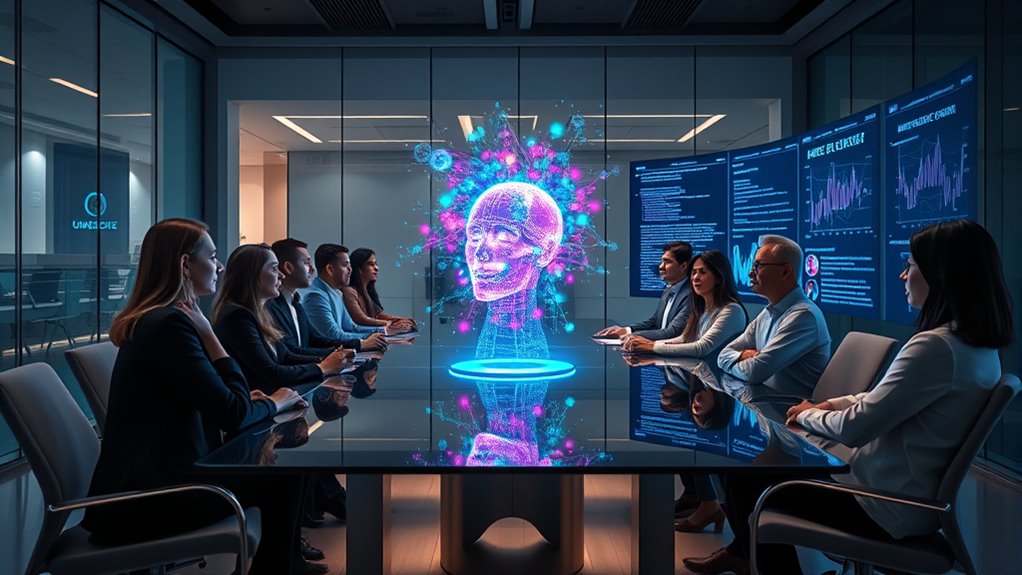
Industry leaders across various sectors are actively adopting AI to transform their operations and gain a competitive edge. Companies like HCLTech use AI to improve manufacturing quality by predicting and eliminating defects with Vertex AI and the Manufacturing Data Engine platform. Ipsos enhances market research through AI-powered data analysis, reducing manual requests. Juganu develops digital twins for retail automation, streamlining store operations with Google Cloud. Nowports leverages AI to predict market behavior and optimize logistics, improving supply chain efficiency. PIMCO built an extensive platform using Azure AI Studio for better client engagement. Meanwhile, firms like PKSHA Technology, Providence, and Raiffeisen Bank implement AI for automating tasks, improving care quality, and boosting productivity. Across industries, AI integration is driving measurable value and transforming how businesses operate daily. AI-driven solutions are increasingly central to achieving operational excellence and innovation. Additionally, as AI advances, its role in shaping workplace dynamics and enhancing efficiency continues to grow, emphasizing the importance of strategic adoption. Moreover, the incorporation of automation in business intelligence accelerates decision-making and reduces errors, further empowering organizations to stay competitive. Furthermore, leveraging training and resources in AI and automation can significantly improve a company’s ability to implement these technologies effectively. Recognizing the importance of data management, many organizations are also investing in data accuracy and consistency to ensure reliable AI outputs and insights.
Overcoming Challenges in AI Adoption
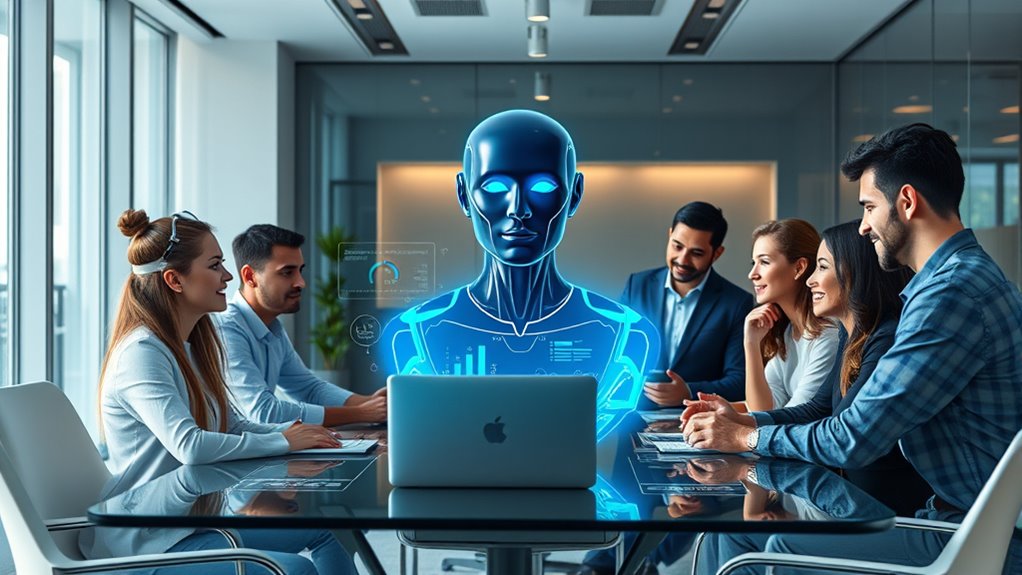
To successfully adopt AI, you need effective training and skill development to prepare your workforce. Implementing clear workflow strategies can ease integration and boost productivity. Addressing resistance involves open communication and involving employees in the changeover process. 75% of surveyed workers use AI at work in 2024, highlighting the importance of ongoing education to keep staff up-to-date with evolving technologies.
Training and Skill Development
Overcoming challenges in AI adoption hinges on effective training and skill development, yet many organizations face significant hurdles. Without proper training, employees struggle to use AI confidently, limiting its potential. Here are key issues:
- Low formal training rates: Only 39% of employees receive structured AI training at work. Furthermore, only 39% of employees using AI receive formal training (Microsoft & LinkedIn, 2024).
- Reluctance and confidence gaps: 52% hesitate to admit AI reliance, and just 37% feel confident in their skills.
- Training needs unmet: Over half of SMB employees believe they need more AI education.
- Slow adoption despite demand: Nearly half want more training, but solution adoption remains sluggish.
Addressing these gaps is vital. Investing in tailored training boosts confidence, encourages frequent AI use, and accelerates integration into workflows.
Workflow Integration Strategies
Successfully integrating AI into your workflows requires careful planning and strategic execution. Begin with a workflow assessment: identify key tasks that AI can optimize and evaluate your current systems to spot strengths and gaps. Set clear objectives for what you want AI to achieve and establish a phased timeline for implementation. Choose tools that align with your needs, starting small with a single AI solution to test compatibility. Configure systems to guarantee smooth integration with existing software, and organize workflows by department or project for efficiency. During pilot testing, gather feedback and monitor performance closely. Make necessary adjustments before expanding. Throughout the process, address technical glitches promptly and guarantee data quality to support AI effectiveness. This strategic approach minimizes disruption and sets the foundation for successful AI adoption.
Addressing Workforce Resistance
Workforce resistance remains one of the biggest hurdles in AI adoption, as many employees harbor concerns about job security and the technology’s impact on their roles. To overcome this, you need to address these fears head-on. Consider these strategies:
- Transparency in AI use – Clarify AI’s role and benefits to build trust.
- Employee involvement – Include staff in AI decision-making to foster acceptance.
- Educational programs – Offer training that explains AI’s capabilities and limits.
- Job security assurances – Reassure workers about their future roles or growth opportunities.
The Future of Human-AI Collaboration
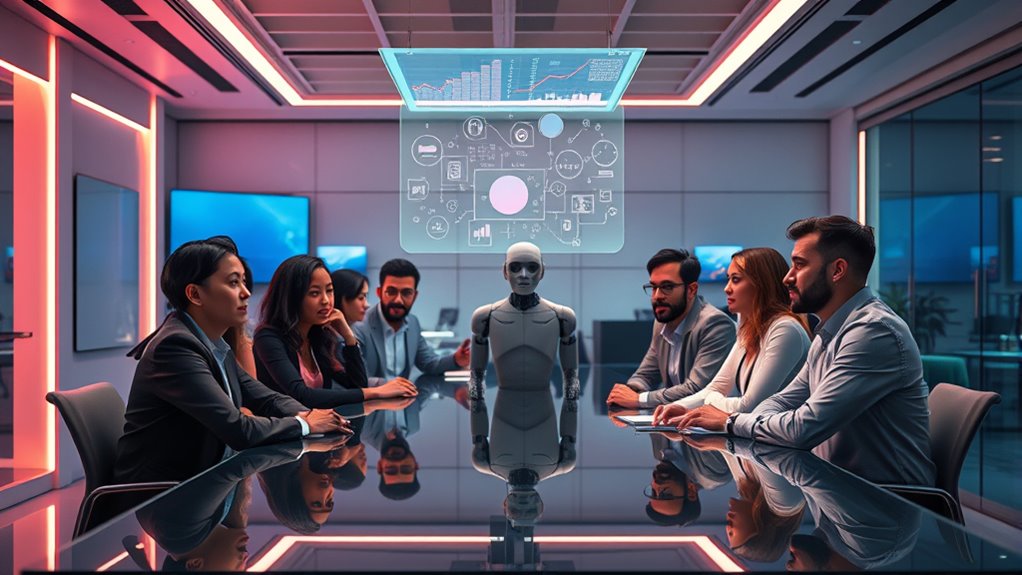
The future of human-AI collaboration is poised to reshape how we work, innovate, and solve complex problems. By 2030, working alongside AI could access up to $15.7 trillion globally, boosting productivity and creativity. Using tools like ChatGPT, you’ll likely see a 37% increase in writing efficiency, especially if you’re less experienced. AI enhances human skills, enabling higher output and more innovative ideas across industries. As collaboration shifts from single models to multi-agent systems, hybrid teams where humans lead AI agents will tackle complex challenges more effectively. Developing new skills and measurement frameworks will be essential to maximize this synergy. Strategic investments in human-AI partnerships will position organizations for long-term success, transforming workplace culture into one that leverages AI to empower and elevate human capabilities.
Preparing Teams for an AI-Driven Workplace

Preparing your team for an AI-driven workplace requires understanding current adoption trends and addressing employees’ concerns. AI adoption ranges from 20% to 40%, with higher rates in tech-related fields. Managers increasingly support AI to boost productivity—77% see it as a helpful tool. Meanwhile, 80% of employees believe AI will benefit their organization by freeing up knowledge workers. However, 30% worry about job security by 2025. To prepare effectively, consider these key points:
Preparing teams for AI involves understanding trends and addressing concerns about job security.
- Develop AI literacy through targeted training programs.
- Foster open communication to address job displacement fears.
- Implement strategic AI integration that enhances rather than replaces roles.
- Stay informed about regulatory changes encouraging AI adoption.
Frequently Asked Questions
How Does AI Impact Employee Job Security and Roles?
AI impacts your job security and roles by automating tasks, which can lead to displacement and role shifts. While some jobs may be replaced, AI also creates new opportunities and encourages skill retraining. You might worry about obsolescence, especially if you’re younger, but many employers now focus on enhancing productivity and supporting employee growth. To stay relevant, embracing AI skills and adapting to changing responsibilities become essential.
What Ethical Considerations Arise From AI Integration?
You might think AI is just a tool, but it raises serious ethical concerns. You need to contemplate bias in decision-making, privacy risks, and transparency about how AI operates. Protecting data security and ensuring accountability are essential. You also should foster trust and prevent dehumanization, making sure AI complements human work ethically. Addressing these issues helps create a responsible, fair environment where AI benefits everyone without compromising values.
How Do Companies Ensure AI Tools Are Unbiased?
You guarantee AI tools are unbiased by regularly examining outputs for disparities and using specialized detection tools like bias scanning systems and confusion matrices. You implement mitigation techniques such as adversarial training and data modification, and keep systems updated based on bias audits. Additionally, you follow policies ensuring transparency and fairness, engage diverse stakeholders, and comply with legal standards—making bias reduction an ongoing, active process.
What Are Effective Strategies for Training Staff on AI Tools?
Training teams to tackle AI tools takes targeted techniques. Start with tailored tutorials that transform theory into practice, boosting understanding. Incorporate interactive, innovative digital simulations that succeed spectacularly in skill solidification. Support staff with structured sessions, supplemented by supportive organizational strategies. Embrace AI-powered tools to enhance engagement, ensuring employees feel confident and competent. Consistent, customized coaching cultivates curiosity, competence, and confidence, creating a culture where AI adoption accelerates seamlessly and successfully.
How Can Organizations Measure Ai’s ROI and Success?
You can measure AI’s ROI by tracking both tangible and intangible benefits. Focus on metrics like productivity gains, cost reductions, and revenue increases, using financial analysis and performance data. Don’t forget softer indicators like employee engagement and customer satisfaction through surveys. Align your measurements with strategic goals and consider long-term impacts, including organizational maturity and cultural shifts. This holistic approach helps you demonstrate AI’s true value effectively.
Conclusion
As AI becomes part of your team, remember that “a rising tide lifts all boats.” Embracing ChatGPT and similar tools can boost your productivity and innovation. While challenges exist, staying adaptable and open-minded will help you thrive in this new era. By working alongside AI, you’re not replacing your skills—you’re enhancing them. Keep an eye on the future, and you’ll find that teamwork with technology can lead to great success.
